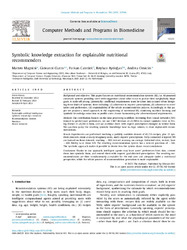Symbolic knowledge extraction for explainable nutritional recommenders
| dc.contributor.author | Magnini, M. | |
| dc.contributor.author | Ciatto, G. | |
| dc.contributor.author | Cantürk, Furkan | |
| dc.contributor.author | Aydoğan, Reyhan | |
| dc.contributor.author | Omicini, A. | |
| dc.date.accessioned | 2023-08-22T10:22:06Z | |
| dc.date.available | 2023-08-22T10:22:06Z | |
| dc.date.issued | 2023-06 | |
| dc.identifier.issn | 0169-2607 | en_US |
| dc.identifier.uri | http://hdl.handle.net/10679/8730 | |
| dc.identifier.uri | https://www.sciencedirect.com/science/article/pii/S0169260723002018 | |
| dc.description.abstract | Background and objective: This paper focuses on nutritional recommendation systems (RS), i.e. AI-powered automatic systems providing users with suggestions about what to eat to pursue their weight/body shape goals. A trade-off among (potentially) conflictual requirements must be taken into account when designing these kinds of systems, there including: (i) adherence to experts’ prescriptions, (ii) adherence to users’ tastes and preferences, (iii) explainability of the whole recommendation process. Accordingly, in this paper we propose a novel approach to the engineering of nutritional RS, combining machine learning and symbolic knowledge extraction to profile users—hence harmonising the aforementioned requirements. MethodsOur contribution focuses on the data processing workflow. Stemming from neural networks (NN) trained to predict user preferences, we use CART Breiman et al.(1984) to extract symbolic rules in Prolog Körner et al.(2022) form, and we combine them with expert prescriptions brought in similar form. We can then query the resulting symbolic knowledge base via logic solvers, to draw explainable recommendations. ResultsExperiments are performed involving a publicly available dataset of 45,723 recipes, plus 12 synthetic datasets about as many imaginary users, and 6 experts’ prescriptions. Fully-connected 4-layered NN are trained on those datasets, reaching ∼86% test-set accuracy, on average. Extracted rules, in turn, have ∼80% fidelity w.r.t. those NN. The resulting recommendation system has a test-set precision of ∼74%. The symbolic approach makes it possible to devise how the system draws recommendations. Conclusions Thanks to our approach, intelligent agents may learn users’ preferences from data, convert them into symbolic form, and extend them with experts’ goal-directed prescriptions. The resulting recommendations are then simultaneously acceptable for the end user and adequate under a nutritional perspective, while the whole process of recommendation generation is made explainable. | en_US |
| dc.description.sponsorship | CHIST-ERA IV project ; Ministry of Education, Universities and Research (MIUR) ; TÜBİTAK | |
| dc.language.iso | eng | en_US |
| dc.publisher | Elsevier | en_US |
| dc.relation | info:turkey/grantAgreement/TUBITAK/120N680 | |
| dc.relation.ispartof | Computer Methods and Programs in Biomedicine | |
| dc.rights | Attribution-NonCommercial-NoDerivatives 4.0 International | * |
| dc.rights | openAccess | |
| dc.rights.uri | https://creativecommons.org/licenses/by-nc-nd/4.0/ | * |
| dc.title | Symbolic knowledge extraction for explainable nutritional recommenders | en_US |
| dc.type | Article | en_US |
| dc.description.version | Publisher version | en_US |
| dc.peerreviewed | yes | en_US |
| dc.publicationstatus | Published | en_US |
| dc.contributor.department | Özyeğin University | |
| dc.contributor.authorID | (ORCID 0000-0002-5260-9999 & YÖK ID 145578) Aydoğan, Reyhan | |
| dc.contributor.ozuauthor | Aydoğan, Reyhan | |
| dc.identifier.volume | 235 | en_US |
| dc.identifier.wos | WOS:000983750400001 | |
| dc.identifier.doi | 10.1016/j.cmpb.2023.107536 | en_US |
| dc.subject.keywords | Explainable artificial intelligence | en_US |
| dc.subject.keywords | Neural networks | en_US |
| dc.subject.keywords | Nutrition | en_US |
| dc.subject.keywords | Recommendation systems | en_US |
| dc.subject.keywords | Symbolic knowledge extraction | en_US |
| dc.identifier.scopus | SCOPUS:2-s2.0-85152230884 | |
| dc.contributor.ozugradstudent | Cantürk, Furkan | |
| dc.relation.publicationcategory | Article - International Refereed Journal - Institutional Academic Staff and Graduate Student |
Files in this item
This item appears in the following Collection(s)
Share this page




